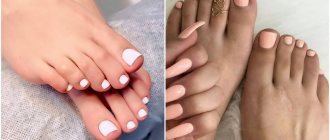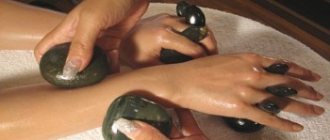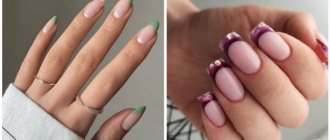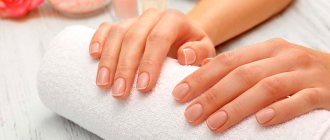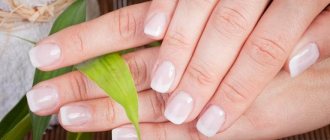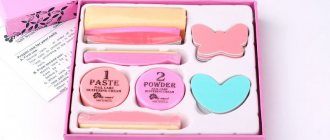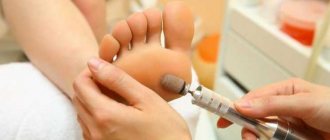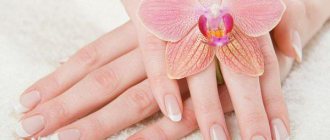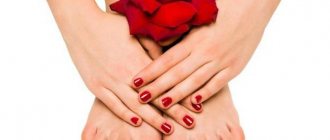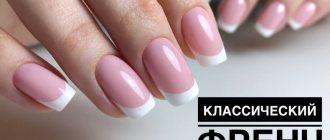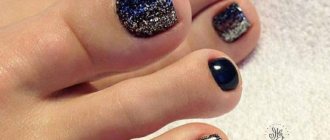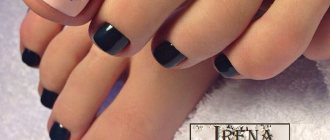- 73175
- 08-04-2021
- Author: Mysekret Team
- 0
Girls always want their legs to look beautiful and well-groomed - both in summer and winter. But few people know that you don’t have to go to a salon for a beautiful pedicure; you can do it yourself at home. This is especially true for those who like to wear sandals in the summer - beautiful and well-groomed toenails are especially important for them.
If a girl has beautiful, well-groomed nails, then she feels confident. Our article will tell you how to properly do a pedicure step by step. We will not use special equipment to perform it at home, which will allow you to enjoy this activity at any time.
If you want to have a skincare procedure done in a salon or beauty center, then pay attention to OLA centers.
See also...
✅ Light manicure is trending this year: 100 gentle ideas
✅ You need to be modern: we study the signs of outdated makeup
✅ The bob has grown: how to get a haircut when salons open
✅ It's time for a pedicure: fresh and stylish ideas for spring-summer 2021
50+ ideas for a fashionable pedicure here.
Professional pedicure
Special rules for disinfecting hands and objects, as well as sterilizing instruments, have been developed for manicure and pedicure specialists. According to them, the pedicurist is obliged to wash her hands before working with the client and after finishing, using an antiseptic . After use, baths must be treated with a disinfectant.
| Sterilization of used instruments is carried out either by boiling or by treating them with disinfectants that have passed state registration. |
The sterilization requirements for pedicurists correspond to the requirements for medical workers . But anyone who has at least visited a dentist can easily tell the difference. When cutting the cuticle, small cuts often occur, causing blood to appear. Getting it on an instrument without proper disinfection is fraught with consequences.
Types of pedicure
There are several types of pedicure. Let's look at each in more detail.
- Medical. Who needs a medical pedicure and why? People suffering from certain foot and nail diseases often seek help. It is provided by a podiatrist.
The medical pedicure procedure is aimed at preventing and getting rid of problems such as ingrown toenails, calluses, heel spurs, etc.
- Classical. It is divided into edged and European. They differ only in the way the cuticle is processed. In a classic trim pedicure, the legs are first steamed and then the cuticle is carefully removed with rounded manicure scissors.
- Dry. There are several names for this type of pedicure: European, French and unedged. With a dry pedicure, your feet do not need to be steamed - the entire procedure is carried out without water. It is replaced by special disinfectants (keratolics), which make it easy to treat the feet from the remnants of old dead skin.
The cuticle is removed using cosmetics or the film is pushed back with an orange stick to the base of the nail. The advantage of a dry pedicure is that it eliminates the possibility of infection with fungal diseases, as, for example, with a classic pedicure.
- Hardware. A pedicure is done with a special device with several attachments. They have different purposes. For example, a diamond cutter is used to cleanse the foot of old and rough skin. Silicone ones are designed for polishing nails.
During a hardware pedicure, cutting objects are not used, and water for steaming is also not needed. The keratinized skin is removed with special cosmetics, and the cuticle is simply trimmed with a nozzle.
Despite the universality of the pedicure procedure, it is extremely important to choose a good and trusted specialist whose tools are always sterilized and whose work area is neat and clean.
If it’s too expensive for you to contact a professional, you can learn pedicure for yourself or read the step-by-step instructions in this article and carefully apply the knowledge in practice. Read on!
Also, some types of pedicure are contraindicated for pregnant women and diabetics.
Why get a pedicure
In the summer - understandable. After all, toes peek out from sandals and open shoes. And you won’t be able to playfully run to the water on the beach without evidence of a serious attitude towards your appearance.
In winter, this becomes important when visiting the pool. You feel better when visiting a doctor and staying in a hospital. If a woman is married, this is a reason to please her husband. It is believed that this is done to please him, because others do not see.
But there is another reason - psychological . Even if others are not aware, a person is constantly aware of what kind of underwear he is wearing, whether his tights or socks are torn. And are your nails in order? This involuntarily affects the manner in which one behaves, gives confidence to one’s facial expression and courage to one’s actions.
Pedicure master class with decor
A pedicure at home for beginners can be done with the following decorative elements:
- rhinestones;
- kamifubuki;
- foil;
- stickers;
- metallized strips;
- stamping.
It is worth considering that you should not overload your nails with decor. Otherwise, the design will look vulgar.
Rhinestones and crystals
Similar decorative elements come in different colors and sizes. They look solemn and festive, and you can lay out entire paintings from them. But rhinestones and crystals quickly come off, so they are not recommended for everyday pedicures. But for an evening look they are irreplaceable.
To make a pedicure with rhinestones and crystals, you need to attach these decorative elements to the finishing coat that has not yet dried. If necessary, they can be covered with another layer of transparent top.
Kamifubuki
This is what colored confetti or sequins are called. Similar decorative elements can be either round or unusual in shape (triangles, stars, hearts).
And they can be used both as single decorations and to create compositions. Kamifubuki, like rhinestones, are attached to the finishing coating. They are suitable for summer design and look impressive against bright and dark backgrounds.
Foil
With foil you can make an original and unusual pedicure that will look appropriate in both everyday and festive looks. And with this decor you can decorate one or more fingers, or in general, highlight some part of the plate.
To do a pedicure with foil, you need to prepare your nails and then attach the decorative sheet to the still wet polish. If desired, you can make various patterns by drawing them with a colorless base. You need to wait 1-2 minutes, and then tear off the foil with a sharp movement.
Stickers
Stickers and sliders help you create an unusual design in a matter of minutes, and even a child can use them. The main thing is to remember that it is advisable to apply white or nude varnish under such decor. It is advisable to treat the top of the stickers with a transparent fixative.
If this decor is used for a pedicure with gel polish, then it must be attached to a non-dried topcoat. And only then should you dry your nails under a lamp. After completing work, avoid contact with water for 30 minutes. Then the stickers or sliders will look perfect for 15-20 days.
Metallized strips
This decor is ideal for creating geometric motifs that have not gone out of fashion for several seasons.
Stripes also help to hide the joints between two contrasting colors of varnish, for example in a French jacket, and they can be used for both everyday and festive looks.
Stamping
Stamping is the application of patterns using stamps. This technique helps you create an unusual and original pedicure in a matter of minutes. It is necessary to apply a base, preferably matte, to the prepared nails. Then the drawing will turn out clear and bright.
You need to apply a bright varnish to a plate with an ornament or pattern, and then use a stamp to transfer it to your nails. You won't be able to get uniform patterns the first time, so you'll have to practice. At the end, be sure to secure the result with a colorless finish.
How nice it is to do yourself
Any self-care gives rise to a positive attitude, which psychologists consider a direct path to happiness. Pedicure is an art. After all, everything ends with painting - applying varnish to the nails.
Modern fashion dictates not the boring application of one color on each nail, but wild imagination. One month it is customary to alternate colors that do not match each other, the next - one nail should be slightly longer than the others. Moreover, it should shine with sparkles, which can be purchased in the store.
Keeping yourself busy wards off boredom and bad mood. No one will be able to give themselves a pedicure and be bored at the same time. A woman begins to feel better about herself, which is always reflected in her appearance. If a pedicure is done regularly and foot care is constantly taken care of, then you can do it quickly and enjoy it.
Finally, by mastering any new knowledge, any of us becomes more free and independent.
Pedicure master class with simple patterns and drawings
Even without artistic skills, you can make a beautiful pedicure with a variety of designs. Moreover, there are several different painting techniques that even beginners can handle.
Using tape
Thanks to this material, you can create geometric shapes, diagonal or vertical lines, thin or wide stripes. To do this, you need to cover your nails with varnish of the main color.
After waiting for the layer to dry completely, you need to stick strips of tape to the plate so that you get the desired design.
The photo shows an example of a manicure, but a pedicure is done in a similar way. After this, you need to cover your nails with varnish, the color of which contrasts with the base. After waiting for the layer to dry, you should carefully tear off the tape and secure the result with a finishing coat.
Drawing with a needle
The simplest design can be made using 2 varnishes of a contrasting color and a regular needle. And you will also need a fixer to work.
Algorithm of actions:
- Apply base polish to prepared nails. Before moving on to the next step, you need to wait until the layer is completely dry.
- On the nail you need to put several dots of varnish that contrasts with the base. Then you need to stretch the needle through these points, drawing monograms and curls.
- When the pattern is dry, you should cover the nail with the finish.
And you can also use a needle to draw thin lines or outline a pattern.
Dots drawings
It is easier to draw patterns with dots than with a needle. After all, with the help of the tool you can control the volume of the drop, which makes the lines even. To create a design, you need to apply a base polish to the nail. And after waiting for it to dry, you should dip the dots “ball” in a contrasting color, and then apply the desired design with it.
Tulle lace
Using a piece of old tulle you can make a lace pattern on your nails. This pattern looks gentle and elegant, and is suitable for both festive and regular pedicures.
Execution algorithm:
- Apply a base to prepared nails and then cover it with a layer of varnish. It is worth considering that it will be the main color in the design.
- After waiting for the polish to dry, you need to apply a piece of tulle to the nail. Then you need to paint the material with varnish of a contrasting color.
- You should wait until the layer is completely dry and carefully tear the tulle away from the nail.
- The obtained result must be secured with a finish.
If desired, this design can be decorated with rhinestones, sparkles or crystals. Then the pedicure will turn out to be more festive.
Required tools and accessories
For a home pedicure you will need:
- Ceramic or plastic foot bath.
- Towel.
- Heel grater.
- Fine grain pumice.
- Tweezers.
- Different types of files.
- Machine.
- Wire cutters.
- Scraper equipped with small blades for heels.
- Nail scissors.
- Softening cream.
- Finger spacers.
- Varnishes of various colors.
- Acetone and cotton swabs for correcting minor imperfections when applying varnish.
- Deodorant for feet.
What is a classic pedicure
The peculiarity of this technique is the use of a set of special tools for processing skin and nail plates. Typically these include:
- nippers or knipser;
- file, pumice;
- pusher and buff.
In addition, a trim pedicure includes a mandatory foot bath to soften dead skin.
Foot baths
The pedicure procedure begins with a warm bath . It involves steaming the feet. At the same time, they soften, which facilitates further processing. You can add ingredients to the water, for example, herbs, various types of sea salt with additives, and essential oils.
Toning.
Mix sea salt, which has the property of strengthening nails, and essential oil. You can enhance the effect by adding dried mint. Proportions may vary.
Antibacterial.
Pour baking soda into the water. For a bath of water - four tablespoons. This baking soda bath is suitable for both treatment and prevention of fungal infections . Eliminates odor.
Relaxing.
Add an infusion of herbs - calendula or chamomile. The infusion is prepared by pouring two tablespoons of dried plants with a glass of boiling water. It should infuse for half an hour. This composition provides a strong disinfectant effect.
Softening.
Add four tablespoons of vinegar to the water ( not to be confused with acetic acid ). Apple cider vinegar will also work. The duration in this case is limited: no more than 15 minutes.
Exfoliating.
Sprinkle table salt. Place your feet in the water for a few minutes. Add two tablespoons of hydrogen peroxide to the water with salt.
After taking a bath, wipe your feet dry with a towel.
How to become a pedicure master?
You can become a good specialist yourself by watching lessons on YouTube and reading articles on the Internet.
Online lessons can teach you how to do a pedicure for yourself, and with due persistence, accuracy and diligence, you can do it just as well as a professional.
However, to work in a good salon, you will need a certificate to prove your qualifications.
If you decide to start making money from your skill, you should take specialized courses.
You need to do this not only for the certificate, but also in order to understand the nuances of the procedure at an even higher level, as well as learn the basics of working with clients.
To avoid regretting wasted time and money, pay attention to the number of hours devoted to theory and practice.
- There should be either as much practice as theory, or an order of magnitude more.
- Find out how many people are studying in the group. In overcrowded groups, the teacher will not be able to devote enough time to each student and you personally.
- The optimal option is 5–10 people in a group. Smaller is certainly better.
- Read reviews about the school, look at the work of former students: do you like the quality of everything?
- Please also pay attention to the course instructor. How competent is he, do he have awards and certificates of advanced training, how long has he been teaching.
After completing a full pedicure course, you will gain the knowledge and practical skills necessary for your work. But don't stop there!
Attend seminars and advanced training courses, track pedicure trends on the Internet, read magazines, specialized blogs and don’t be afraid to experiment.
Stages
Main stages of pedicure:
- Foot baths.
- Remove any remaining nail polish applied last time using products specifically designed for nail polish remover.
- Shorten the length of your nails. Do not file them, but trim them with small tweezers.
- Soften the cuticle. Apply a softening agent to the surface of the nail and the sides.
- Treat the heels, removing rough skin from them. A special machine is driven along the surface towards the edges of the heel. Remove rough skin in thin layers, being careful not to damage the lower layers.
- Sand the surfaces of the feet with a coarse file.
- Use tweezers to treat cracks on the heels. When working, they should be placed along the crack.
- Remove dead skin on the fingertips. Use a soft file to sharpen the surface of the pads and the places where the fingers touch.
- Treat the cuticle. Wipe this area with wet wipes. Use a special spatula to move the skin from the middle to the edges.
- Finish the edge of the nail. Use a file to give it a square shape to avoid ingrowth .
- Treat the nail plates with disinfectants.
- Apply a nourishing cream to your heels to prevent cracks.
- Give a foot massage.
- Cover with varnish. Can be done in several layers. Additionally, a clear varnish can be applied on top.
Trim pedicure at home
It is recommended to perform the procedure once every 10-14 days at home, depending on the load on the legs. This intensity will allow you to properly care for the skin of your legs and feet, preventing the appearance of cracks and ingrown nails. Between the full procedure, it is recommended to sand your feet every 3-5 days with a coarse file to remove rough skin.
Classic pedicure is easy to learn. To do it as efficiently as possible, take care of good tools and nail files. This is already half the battle. It will take you about an hour to complete. You can turn on your favorite TV series.
How to perform a classic pedicure step by step:
- In a classic pedicure, steaming your feet is mandatory. To do this, immerse them in a bath of water at 37-40°C for 10-15 minutes. First add 1 tbsp to the water. l. salt, 1 tbsp. l. soda and a little liquid soap or shower gel. Baking soda will additionally soften and whiten the skin, and salt will strengthen nails and relieve swelling. You can also add a few drops of essential oil, such as tea tree, lemon, rose or lavender, to the water.
- Use a pusher or an orange stick to push back the cuticle and clean up the pterygium from the nail plates.
- Use pliers to remove the length of your nails. Do not cut it very short, the recommended length is 2-3 mm.
- By this point, your nails will have dried a little, so you can shape them with a nail file. With a rectangular shape, it is still better to round the corners a little so that they do not cling to socks or tights and do not grow into the skin.
- Use the sharp end of an orange stick to remove dead skin from under the nail plates and in the lateral sinuses. Do this very carefully so as not to injure the nail.
- Use nail scissors or cuticle cutters to cut the cuticle. Professional craftsmen recommend removing only rough, dead skin, without fanaticism. The cuticle protects the nail along the perimeter, and if it is cut very short or injured, pockets of possible infection will form with a high risk of inflammation due to contact with shoes, dust, and floors.
- Now let's move on to processing the feet. Using a grater or coarse file, remove all rough skin in the direction of the skin lines. It is recommended to do this not on wet, but on barely damp skin. If it dries out, just moisten it a little with your hand. A grater or file will remove the rough areas in pellets. If there are cracks on the legs, then they must be processed with a grater strictly along the groove.
- Apply a coarse scrub to your feet and massage your feet and upper parts. Rinse with water.
- Apply a decorative coating to your nails with gel polish, shellac or regular nail polish. If gel polish is used, then leveling is not necessary. A thin layer of classic base will be enough. Before applying it, treat your nails with a dehydrator and an acid-free primer for better wear of the coating. It is better to take the top without a sticky layer. Many masters recommend using a single-phase polish for pedicure, combining a base, gel polish and top coat at the same time.
- Apply a light cream for quick absorption and cuticle oil to your feet. Give a light massage to relax your legs and improve the effect of the cosmetic product.
Precautions for trimming pedicures
- Do not use hot water for a bath above the specified 37-40 degrees, even if the temperature above seems comfortable to you. Hot water draws moisture from the skin and also improves blood flow to the feet. If you accidentally get injured while cutting the cuticle, the blood will flow more actively;
- To trim the cuticle, use only sharply sharpened tools, otherwise burrs cannot be avoided;
- Do not forget that tools that damage the integrity of the skin - scissors and nippers - require treatment even at home and even if only you use the devices. Ideally, periodically soak the devices in a disinfectant solution, but as a last resort, at least just wash them in soapy water and treat them with an antiseptic, chlorhexidine, or alcohol;
- If you use a grater or pumice stone with a reusable surface to treat your feet rather than replaceable files, change the device for a new one at least once a month. Particles of skin and moisture remain in the porous structure of pumice, which subsequently becomes a suitable place for the development of various microorganisms. You can also use a special pedicure machine to remove dead skin, but use it carefully, without strong pressure, so as not to damage the living skin.
Also, do not forget that trimmed pedicure has contraindications:
- Diabetes;
- Fungal infection;
- Poor blood clotting;
- Proximity of blood vessels to the surface of the skin;
- Varicose veins
Mistakes when performing a pedicure
The most common mistakes:
Do not soften your feet in too hot water. The temperature should be no more than 30 degrees . You can keep your feet in the water longer.
When removing calluses and corns, do not use scissors or a blade. This may cause cuts. To do this, use a pumice stone or a scraper.
Do not cut the corners of the nail to avoid ingrown nails. Correctly cut your nails in a straight line.
Products for high-quality pedicure at home
A good pedicure involves not only processing the cuticle and carefully applying gel polish. It is also important to clean your heels, get rid of foot fungus and take steps to get rid of bunions. Here are some good remedies to use at home:
Pedicure socks Baby Foot
These socks have been popular in Japan for more than 15 years and have finally reached us. They are extremely simple to use: put them on, wear them for 15-20 minutes, remove and wash the product off your feet. Around day 2-3, the rough skin will begin to peel off.
Nomidol cream for foot fungus
Fungus is a popular problem of our time, which is most often caused by poor hygiene and poor-quality shoes. You can get rid of fungus. choosing a quality product. One of these is Nomidol. In just a couple of days, the itching goes away, sweating decreases, and after 30 days the feet take on an absolutely perfect appearance.
Gel gloves and socks
If there is no fungus and there is no need to exfoliate rough skin, pamper yourself with gel gloves and socks for spa care. Silky skin and a feeling of complete relaxation are guaranteed. Experts recommend!
Ointment "ValgusStop"
A protruding bone on the foot, calluses and corns are also common problems that can be dealt with by choosing a quality product for home use. ValgusStop ointment gives noticeable results in just 1 month of use.
Heel treatment
There are two types of heel treatment tools. If the condition of the heel is not very advanced, using a grater is sufficient. Otherwise, machine processing is necessary.
Processing with a grater
It is better to choose a grater with a wooden rather than an iron handle. The processing surface is made of pumice, plastic, nickel, stainless steel. The rough surface is created by notches applied by a laser.
| It is advisable to choose double-sided graters with different coatings - hard and softer. |
Having steamed your legs, first treat the heel with a harder coating, moving in one direction - from the sides and from the back to the middle.
Then rub the corns on the bottom of the fingers and on the side of the thumb with a grater. The leg is placed back into the bath. Take it out, dry it with a towel and treat the other leg in the same way.
Then the first one, taken out of the water and dried, is treated with the side of the grater with a softer coating, increasing the processing area. The second leg is being treated.
Processing by machine
Blades are included with the machine. The preparatory step is steaming the legs with the addition of the desired components. Then you need to wipe your feet dry. Using light movements, without creating excessive pressure, begin to treat the foot, paying attention to the roughest areas. Direction: from the edges to the center of the heel.
The final stage will be to re-immerse the feet in the bath, and then treat the skin with a sanding file. Finally, apply the cream.
Treatment frequency
Beautiful toenails need constant care.
How often should you get a pedicure? How often is it recommended to carry out the care procedure? If there are no ingrown nails, corns, calluses, or other foot problems, the frequency of the procedure is once every 2.5-3 weeks. In summer you can get pedicures at home more often, in winter - less often.
How to do a pedicure correctly? If you don’t have enough experience or don’t have the tools, you should go to a beauty salon. A specially trained master knows how to care for your feet. He will not only put them in order, but also tell you how to deal with sweating, fungus, calluses, and corns.
What you will need for care:
- A container of hot water will help to thoroughly steam your feet.
- Bath salt, decoction of herbs, for example, chamomile, St. John's wort, celandine, coltsfoot.
- Pumice stone or a special grater to remove keratinized epithelium.
- Cream, liquid for softening cuticles.
- Nourishing foot cream.
- Nail strengthener.
- Towel, napkin.
If you plan to not only do a pedicure yourself at home, but also decorate your nails, you should stock up on varnish and special separating pads.
Cuticle treatment
The function of the cuticle is defense. The base of the nail is protected from infections entering this area. When doing a pedicure, the goal is to get rid of dead cuticle cells. As the cuticle grows, it dries out, causing hangnails to appear. Nails grow more slowly and their appearance deteriorates. Only constant care for the condition of the cuticle will make it healthy and give it a well-groomed appearance.
Trimming method
A method when the cuticle is trimmed with scissors or tweezers. Preference is given to tweezers made of hand-sharpened high-quality stainless steel.
Steam your feet in the bath. Remove one foot and dry it with a towel. Apply a product that has a softening effect to your nails in the cuticle area. Keep it on your nails for a little while. Take a damp cloth and remove any remaining product.
Take a spatula from the pedicure set and begin to carefully push back the cuticle, moving from the edge of the nail to its middle. Then take out a tool with a sharp end from the set and go through it, cleaning the skin of the thin layer that grows on the nail. Perform carefully without scratching the nail.
Take the tweezers and trim the skin around the nail. Trim your cuticles one at a time to prevent hangnails. Lubricate the cuticle area with the oil intended for this purpose. Treat the second foot.
| It is recommended to purchase tweezers in two sizes. Make large cuts first, and then use smaller tweezers in the corners. |
Unedged method
With this method, keratolics are used instead of tweezers . When applied, the cuticle softens. Then she moves away with the help of an orange stick. Then you need to apply a cuticle remover. After some time, the cuticle is pushed back again. The pedicure ends with cuticle oil treatment.
The advantage of this processing method is safety. With this method, only dead skin areas are removed, while the living ones remain as protection against bacterial infection.
Types of treatment for classic pedicure
Classic pedicure goes well with various methods of treating and caring for the skin of the feet and nail plates. At the request of the client, conventional trimming techniques can be supplemented with useful procedures. Today the following types are most in demand:
- SPA pedicure with chocolate wrapping of feet, application of exfoliating, nourishing and restorative masks. Socks soaked in natural oils, fruit acids, as well as paraffin therapy are used;
- exotic pedicure with Garra Rufa fish. The feet are lowered into a small aquarium container in which tiny fish swim. They effectively remove softened skin particles. The procedure itself causes a pleasant sensation with a slight tickling sensation;
- pedicure with ice cream. Ice cream balls made from vegetable oils are added to the bath. Gradually melting, they are absorbed into the skin and nail plates, nourishing and restoring them. Next, the softened skin is treated with a special scrub;
- A pedicure with a professional foot massage relieves chronic leg fatigue, improves blood circulation, and gives muscle tone. The skin becomes healthier, the legs are less sore and tired.
For each client, the nail master chooses an individual set of procedures. The condition of the skin and nail plates, the woman’s availability of sufficient free time, and contraindications are of great importance. So, if a person is allergic to chocolate or one of the components of the nourishing mask, it is better to refuse this procedure.
View this post on Instagram
Posted by Unreel (@extremeofficial)
Hardware method
Unlike the classic one, the hardware one does not require steaming the legs . A special oil is used to soften. The product acts selectively only on keratinized and dead skin. Living areas are not affected. Provides healing and disinfection effect.
Processing is carried out using grinding attachments and machine cutters. There is no cutting of the cuticle. It is impossible for an injury to occur.
The kit includes nozzles of various diameters. Nozzles of large diameters are used when there is a need to treat the feet, especially the heels. Small nozzles with a semicircular shape are used when the areas between adjacent fingers and the skin near the nail are treated.
The design consists of a device and a handle on which attachments are attached. First, the legs are treated with a coarse nozzle. Then, with a large amount of dead skin removed, they are replaced with more delicate ones. There are attachments designed for different areas of the foot. Nails, cuticles, periungual skin, calluses, and heel cracks are subject to care.
Stages of implementation
- Apply softening cream for about fifteen minutes.
- Remove dead and rough skin using attachments.
- Using cutters, remove corns and treat calluses.
- Sand the cuticles.
- Using a nail file, give them the desired shape.
- Polish.
- Sanding to achieve final gloss.
- Apply emollient cream.
- Massage your feet.
- Apply varnish.
The technology for performing hardware pedicure is clearly shown in the video below:
Treatment of calluses
The pedicure apparatus includes a nozzle for removing calluses . It removes calluses delicately without damaging the skin. A cream is placed in the remaining hole, which removes the roots of the callus being treated.
Circulation
During treatment, the device constantly massages. As a result, blood circulation improves, which has a beneficial effect on the skin of the foot.
After a pedicure performed using a hardware method, the skin that was removed does not begin to grow as quickly as when the pedicure was performed using a trimming method. The skin retains its elasticity for a longer time and becomes much less rough.
Hardware pedicure at home
In the absence of experience with the device, many beginners have a question: how to do a hardware pedicure at home correctly? What materials and attachments are best to take, if you have no experience, we recommend reading the link. Let's look into the details.
Since hardware pedicure is performed dry and without cutting tools, you will need the correct cutter attachments to work on all problem areas.
Materials and attachments for hardware pedicure at home:
- Device with a power of at least 30 W
- Diamond cutters: truncated cone, flame and ball
- Sanding sand caps and silicone sanding pads
- Foot cream
- Cuticle oil
- Decorative coating upon request
Performing a hardware pedicure at home with your own hands can be a difficult task without proper practice. It is necessary to confidently hold the handle of the machine with the cutter so that cuts do not form and do not injure the skin of the cuticle.
When working with attachments, make sure that your working hand has a good support. Use your little, ring and middle fingers for this.
- Use a diamond cutter to move the truncated cone with a blue notch and slightly lift the cuticle. Use the same cutter to shape your nails.
- Using a flame cutter with a blue notch, open the cuticle even further and remove all the pterygium around the perimeter of the nail. Hold the cutter almost parallel to the nail plate, do not press hard.
- Use a diamond-coated ball cutter to gently cut the cuticle, moving from bottom to top from the nail.
- Use a silicone polisher to treat the cut area.
- Use sand caps to treat the foot, metatarsus, and toes. Move evenly along the lines of the skin. Don't stop for a long time in one area.
- Use the silicone sanding pad to sand the foot and metatarsus again.
- Apply cream to your feet and oil to the cuticles, give a relaxing or toning massage.
A properly performed hardware pedicure lasts 2-3 weeks. Then the procedure must be repeated. We have already talked in detail about hardware pedicure in this material, but here we discussed how to select, use and store cutters for the device.
Applying varnish
When applying varnish, it is convenient to use finger separators . This will protect you from accidentally getting varnish on an adjacent nail, especially if they were supposed to have different colors.
Before painting your nails, you need to degrease them with a product that does not contain acetone . A special base must be applied under the varnish. The varnish is applied in two layers with a special brush. The procedure is completed by applying a fixative.
Pedicure with gel polish at home
Pedicure with gel polish at home is very easy to do with your own hands. It lasts for more than 3 weeks, and its color does not lose its saturation over time.
For this you will need:
- Gel-varnish,
- Base and coating
- Nail degreaser,
- Cotton pads,
- UV lamp.
Application steps:
- First, let's remove the old polish, trim the cuticles and take care of the heels. After this, the nail is shaped, if it has not already been shaped.
- The base coat is applied immediately after degreasing the nail. This coating is kept under the lamp for about 2 minutes.
- The product is applied in 2 layers, each of which is also dried under a lamp.
- Top coat and its subsequent polymerization in a lamp.
- The sticky layer is removed and the oil is rubbed into the cuticle.
How to prepare for a dry pedicure
To prepare your feet for a pedicure, do not soak your feet - use disinfectants that contain additives that protect the skin from drying out. The composition is applied evenly and rubbed until completely dry. The master disinfects his hands and always uses disposable gloves. Files and cutters used repeatedly are constantly sterilized and stored in craft bags or boxes. Cardboard files, polishers, and orange sticks are disposable instruments and are discarded after completion of the procedure.
recommends the following dry pedicure protocol:
- We treat the client’s feet with TOTALDIS professional skin antiseptic in the form of a spray. The product is effective against gram-negative and gram-positive bacteria, viruses, and fungi.
- We correct the shape of the nails.
- Apply Cuticle Remover LUX from DOMIX GREEN PROFESSIONAL to the cuticle. After 5 minutes, remove the softened cuticle with an orange stick or cutter.
- Apply Foam Express Softener LIQUID BLADE onto a paper napkin folded in half. Place a napkin on the surface of the foot. The exposure time is 5–20 minutes, depending on the condition of the skin of the feet. After the time has passed, remove the remaining product with a napkin and clean the loosened keratinized areas with a grater or pedicure device.
- We apply the universal keratolytic neutralizer DOMIX GREEN PROFESSIONAL to the skin of the feet.
- We wipe our feet with a dry cloth.
- Using gentle massage movements, apply nourishing cream to the skin of the feet.
- We degrease the nail plate using the professional product NAIL PREP 3 in 1 from DOMIX GREEN PROFESSIONAL.
- We apply a medicinal or decorative coating to the nails.
Financial benefits of dry pedicure procedure
We have already talked about how safe the dry pedicure procedure is; now it’s time to outline the financial benefits. Dry pedicure eliminates the need to purchase baths, disposable liner bags and other equipment and products necessary for performing a classic pedicure with maceration. You may think that this is not significant, since you will have to purchase large volumes of keratolytics, but we hasten to reassure you: all products of the LIQUID BLADE brand are used very sparingly. For example, a bottle of foam softener with a volume of 260 ml is enough for 141 applications, and one liter of product for local use is enough for 2000. Simple calculations lead us to the following figures: the cost of one procedure for a master or salon owner will cost 30–70 rubles, depending from the choice of products for pedicure.
